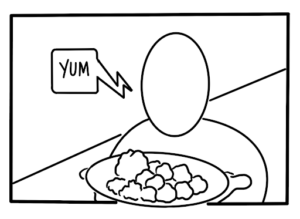The Power of Vision Statements for Teams
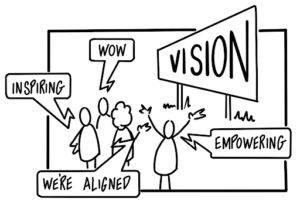
As a leader, I feel it’s my duty to inspire and guide those I work with to deliver value and enjoy their work – so hearing this statement takes the wind out of my sails.
To compound this feeling, my team often asks me – as the leader – to make decisions or give my opinions on every facet of their work – from “how thorough do I need to be with this feature” to “should it do this or that?” And when I express my opinion, they often give me a look that conveys, “…that’s not how I’d do it, but you’re the boss!”
Now don’t get me wrong, I have long been an agilist – I’ve worked with teams to refine the backlog, break work down, negotiate good acceptance criteria, etc. But I often get this over-arching feeling that my team isn’t as invested in the product as I’d like them to be. And as someone who really cares about how people feel about something that consumes so much of their life – their work – this bothers me.
Since becoming a coach, consultant, and trainer, I’ve long reflected on this and have made a simple but profound realization that we, as a team, lacked a clear vision. That’s not to say we didn’t have a sense of purpose, but it was cloudy and vague and we couldn’t all say in unison what it was.
A vision has power – far beyond providing us with a short catchy statement – it can inspire, align and, even better, empower people.
Example – Ikea
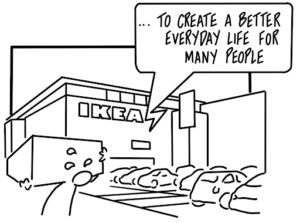
Ikea is a Scandinavian furniture maker and retailer that is known for a range of relatively affordable, flat-packed, self-assembly furniture and home goods… and some delicious Swedish meatballs and gravy in their restaurants – but let’s stay focused…
Ikea’s vision is this: “Our vision is to create a better everyday life for many people.”
It’s short, it’s simple, and it’s profound. A vision without context though can seem a little trite – and lets not forget Ikea makes furniture – and so this vision is embellished by that context.
Their statement contains other components, but it also states that their ‘business idea’ is “to offer a wide range of well-designed, functional home furnishing products at prices so low, that as many people as possible will be able to afford them.”
So, to summarize: They improve lives by helping people furnish their homes with good quality, affordable furniture.
That makes sense to me as a consumer of Ikea furniture. But what about the people who work for Ikea? How does this vision inspire, align and even empower their workforce?
Inspiration
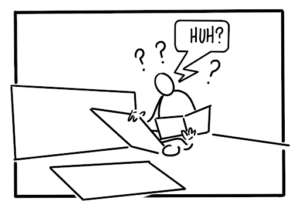
So it’s an inspiring mission, that is also a call to action – an invitation to join the mission.
Maybe that’s why their store designers have created large retail spaces that lead hundreds of people through beautifully designed sets of furniture in situations that both inspire and tempt their customers in equal measure – almost saying “look; here’s how your life, your home could look and feel better.” The design teams of those stores know their mission – and they deliver on it.
So firstly and foremostly the vision sets out our overall mission and values. It can inspire the consumers of the products we create, and those that create the products. It’s the basis of a relationship, be that ‘business owner and staff,’ or ‘company and customer.’ And it’s the basis of a decision – would I buy from, or work for a company like you?
Align
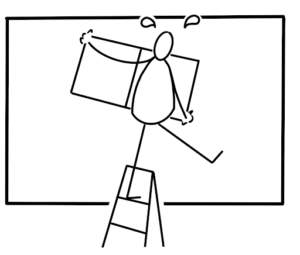
But you can buy a well-designed table from Ikea – in fact, you’ll be spoilt for choice. There are ‘many’ tables, to suit ‘many’ budgets – but they are all relatively affordable and you have to take them home and build them yourself.
A clear vision
I was once a design student, fresh from design school with high ideals on making my name amongst the elite of society by designing exclusive, luxurious, and expensive tables and chairs for the privileged to dine at. Surely a business like Ikea would have snapped me up as a new designer. Well, probably not. I had the skills – but did I share the values? Ikea may have wanted my enthusiasm and my eye for design – but they didn’t share my goal of designing high-end furniture.
Their vision statement is clear – and there is a constraint implied: affordability. That means it needs to be factored into their designs, choice of materials, distribution of furniture – even how customers have to self-build it.
Every item on Ikea’s shop floor is testament to this ideal, ‘our products are good enough that people desire them – but they’re not exclusive, they are for everyone.’
So Ikea designers design simple and cheap furniture. They also design slightly more complex and slightly more expensive furniture – but all within a range and all with their customers (the many) in mind.
Focus helps eliminate waste
Sure, it constrains what they sell and do – but that in turn creates focus. And focus helps eliminate waste. They won’t waste time trying to attract those that don’t share their values, they won’t waste effort and resources creating goods that many of their customers can’t afford, and they’ll be consistent in their approach. Their customers learn to trust that.
A good vision includes a constraint – the constraint of direction. We’re going this way, not that way. If you get lost, you can find your way back – just ask yourself ‘is what I’m doing taking me in that direction?’ If not, ask ‘why am I doing it?’
A good vision is a ‘lean thinking’ tool. It forces us all to focus on what matters, what truly has value – and by default forces us to question and eliminate what does not. All of us, together – aligned.
Empower

I mentioned earlier how, as a leader, I’m regularly asked to sanction decisions, or even make them on behalf of people who should have more knowledge than me on the work they were doing. We hire people for the skills and the experience they bring to the job. And we spend a lot of time and effort finding the right people. Why then would we want to make decisions and direct those people? It seems an awful waste of that effort we spent in finding them.
If someone has the skills to do something, then all they need is a direction, or a goal, they can direct their skills and experience towards.
A vision gives us clarity – it’s our north star, and guiding light. We all know where we’re going because we can see it. It illuminates our path, so we can make choices on how we get there as we go. We don’t need to ask if crossing the bridge is a better option than going the long way round. We’re going north.
Ikea’s furniture designers have a constraint, provided by the clarity of the vision. This does not restrict them, however. They have been hired because they have skills and competence. They are highly inventive in how they use their resources and knowledge to create desirable yet affordable furniture that people want. And millions of people do. The vision has provided this empowerment for the designers to use their skills to create value fit for their customers, in many different and exciting ways.
Visions empower autonomy.
Summary
So, this has all been very poetic but what about how this relates to our day-to-day work?
A vision gets us out of bed and to work every day. “I want to contribute to that.”
A vision tells us where we’re headed, and informs our choices. Should we choose this feature of the product next, or should we choose that? We have a clear idea because it’s the feature that will take us closer to our destination.
And our colleagues know that too, they’re making similar choices, and their choices fit with ours because we’re all headed north, not in different directions – so we’re all helping each other move forward.
And if that vision describes the distant horizon, then a near term plan will get us closer – so this sprint’s goal, this sprint’s smaller vision, describes that step in the right direction. It helps us to focus on what we need to do next to get there. And if we deviate, then we merely have to remember the goal to correct ourselves and get back on track.
We don’t need reminding, and we don’t need to ask. We have that autonomy – because we have a vision.
And if we get hungry on the way… there are Swedish meatballs and gravy!
